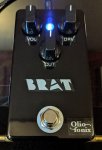You are using an out of date browser. It may not display this or other websites correctly.
You should upgrade or use an alternative browser.
You should upgrade or use an alternative browser.
Informant Overdrive
- Thread starter Jovi Bon Kenobi
- Start date
Jovi Bon Kenobi
Well-known member
I'm almost certain it does. The original maker's website is really frustrating but I swore I read it there somewhere, though I can't find it now.
Like the Klon, yeah?The output is switched between the buffer output and the effect output.
Wait what? What do you mean by "buffer and effect in parallel"? Or by parallel do you mean something like "by extension", describing the klon bypass logic?The input is always connected to the buffer (and effect in parallel).
Is the relay a spdt or dpdt and only using one of it's switches for the effect?
Robert
Reverse Engineer
Similar to the Klon, but not exactly. The buffer stage isn't part of the effect signal path.
In the Klon the buffer is an integral part of the signal path even when the effect is active.
The PCB input goes to the buffer and to the distortion effect in parallel. The footswitch (or relay) selects between the output of the buffer or the effect signal path.
I'll have the schematic posted in the next couple days.
In the Klon the buffer is an integral part of the signal path even when the effect is active.
The PCB input goes to the buffer and to the distortion effect in parallel. The footswitch (or relay) selects between the output of the buffer or the effect signal path.
I'll have the schematic posted in the next couple days.
Last edited by a moderator:
Robert
Reverse Engineer
Looking at that schematic I still don't get the point of that bypass configuration. Are they not using that second relay switch? So a SPDT relay would've sufficed. And what's the point in keeping the bypass buffer connected?
Keeping the bypass buffer connected eliminates a point of pops from charging / discharging the input cap.
The second half of the relay was used to short the clipping diodes to ground. It really made no difference in prototyping and would have just complicated the 3PDT wiring, so I didn't bother with it.
short the clipping diodes to ground.
so both sides to ground?
Does this not lead to tonesuck to keep the effect connected in bypass? Isn't this what dpdt switches and true bypass always tried to avoid?Keeping the bypass buffer connected eliminates a point of pops from charging / discharging the input cap.
I use a label maker too. Just started using clear coat also. 3~4$ at Home depot and looks nice. Labels blend in a little more and won't peel so easily.Quick and easy build! I used a DPDT footswitch for the buffered bypass option. It sounds pretty great. It's a bit smoother in it's clipping that what I remember my Rat having. I used the label maker for the lettering. Thanks for looking.
View attachment 641View attachment 642
Similar threads
- Replies
- 4
- Views
- 250




